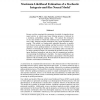Free Online Productivity Tools
i2Speak
i2Symbol
i2OCR
iTex2Img
iWeb2Print
iWeb2Shot
i2Type
iPdf2Split
iPdf2Merge
i2Bopomofo
i2Arabic
i2Style
i2Image
i2PDF
iLatex2Rtf
Sci2ools
NIPS
2003
2003
Maximum Likelihood Estimation of a Stochastic Integrate-and-Fire Neural Model
Recent work has examined the estimation of models of stimulus-driven neural activity in which some linear filtering process is followed by a nonlinear, probabilistic spiking stage. We analyze the estimation of one such model for which this nonlinear step is implemented by a noisy, leaky, integrate-and-fire mechanism with a spike-dependent aftercurrent. This model is a biophysically plausible alternative to models with Poisson (memory-less) spiking, and has been shown to effectively reproduce various spiking statistics of neurons in vivo. However, the problem of estimating the model from extracellular spike train data has not been examined in depth. We formulate the problem in terms of maximum likelihood estimation, and show that the computational problem of maximizing the likelihood is tractable. Our main contribution is an algorithm and a proof that this algorithm is guaranteed to find the global optimum with reasonable speed. We demonstrate the effectiveness of our estimator with...
| Added | 31 Oct 2010 |
| Updated | 31 Oct 2010 |
| Type | Conference |
| Year | 2003 |
| Where | NIPS |
| Authors | Jonathan Pillow, Liam Paninski, Eero P. Simoncelli |
Comments (0)

